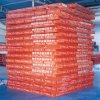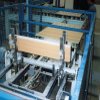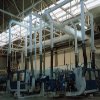In an unlikely new market
16 August 2005For many reasons, among them economic, cultural, and climatic, Brazil is an extremely unlikely market in which to find laminate flooring catching on.
Indeed, even the manufacturers of such flooring admit they face an uphill struggle in trying to get more than a fraction of the population in this vast South American nation to abandon traditional floor surfaces for their product.
Today, the Brazilian laminate flooring industry association, ABIPLAR, acknowledges that an overwhelming 90% of all flooring consists of ceramic tiles. Laminate flooring accounts for just 1.7% of the market with solid wood, carpeting and vinyl making up the rest.
It is rather surprising, therefore, to find some of Brazil’s largest and most experienced wood based panel manufacturers heavily committed to the production of laminate flooring. Not only that, but their number has grown with the addition of at least one optimistic convert to the sector.
With annual production remaining almost static at around six million m2/year over the last three years, it is clear that major panel players such as Duratex SA, Eucatex SA and Tafisa Brasil SA are in this business for the long haul.
They were joined by sector newcomer Fibraplac Chapas de MDF Ltda of Porto Alegre which launched its first panel plant in 2003 with a 180,000m3/year MDF line. Late last year, it started up a 1.5 million m2/year Homag laminate flooring line, although this is not yet operating commercially.
Flooring manufacture in Brazil goes back to 1998 when the two São Paulo-based panel makers, Duratex and Eucatex, launched their respective lines a few months apart. “At the beginning, we had very fast growth which continued from 1999 through to 2002. But in the last three years, the market has stayed at almost exactly the same level,reported current ABIPLAR president and Eucatex’s civil construction division commercial director, Claudio Ferreira de Oliveira.
There is little doubt that the laminate flooring players have been somewhat disappointed with the pace of progress in the domestic market, following their heavy investments. “Six or seven years ago we thought laminate flooring could grow a lot but things are not as easy as we thought at that time,admitted Mr de Oliveira.
So, what are laminate flooring’s advocates up against in Brazil? While the national economy is improving the lot of poorer Brazilians, this product is aimed at the top end of the flooring market. Those normally able to afford such a sophisticated product are, by contrast, currently facing serious economic difficulties, explained Mr de Oliveira, interviewed by WBPI in São Paulo in May.
In price terms, traditional flooring has a huge advantage with a good tile product costing around 20 reais (US$8) per m2, installation included, whereas laminate flooring sells for more like 50 reais per m2 including installation, according to the ABIPLAR president.
Costs are high for the manufacturer, even after he has made the huge initial investment to set up his particleboard or MDF substrate line. The flooring standard in Brazil is very similar to that in Europe and the producer has to pay international prices for raw materials like overlay and papers, Mr de Oliveira pointed out.
On top of that, the manufacturers have to invest huge sums promoting what is still a relatively new product in the country. “To develop the market, you have to invest a lot in marketing, so our marketing costs are much higher than in Europe.
“It’s a matter of culture and convenience in Brazil and you have to invest a lot to change this culture. It is one big obstacle to introducing laminate flooring,the ABIPLAR president explained.
That culture is rooted in logic. As the climate in most of Brazil is hot and often humid, people prefer the cool of a tiled floor, particularly in the office environment, and in humid coastal and interior regions.
Despite producers’ recognition that they have a mountain to climb in getting over their message, they remain quietly confident of an eventual breakthrough. “Now the market is staying at the same level, but I think it will grow, not in a short period but in the long term. It is a good area to be in still,declared Mr de Oliveira.
Unlike Europe, Brazil does not have the benefit of a developed DIY market through which the wood flooring can be channelled. In a country where labour is cheap, customers rely on installers to fit their floors.
To counter early problems experienced in the quality of installation ABIPLAR, along with the producer companies, is backing a continuing training programme for would be installers. To date, the association has trained more than 2,200 laminate floo ring installers all over Brazil, said the president.
Flooring manufacturers have been investing in a range of new products and different designs for the domestic market. In its quest to reinforce its presence at the high end of the market, Duratex last year planned to introduce new products, including an embossed-in-register pattern.
Early in 2004, Tafisa Brasil of Curitiba caused somewhat of a stir in the industry when it launched a ‘click-in’ glueless laminate flooring product, apparently contrary to an understanding with other producers.
This type of flooring, used widely in North America, was felt to be less suitable in Brazil because the glued version offers more resistance to moisture. “People use a lot of water to clean floors in Brazil (normally tiled), so they think in general that this is suitable for cleaning laminate flooring,admitted Mr de Oliveira. The glue fills joints giving greater moisture protection.
Tafisa Brasil’s unilateral move sparked retaliation from Duratex which launched its own high-end ‘click-in’ flooring product at Brazil’s civil construction fair in April last year. Even so, it is understood this has not yet been available generally in the market.
In general the Brazilian laminate flooring industry has been following the trends in Europe in both technology and pattern design. The natural wood look, popular in Europe, “goes down very well in Brazil as well,said Mr de Oliveira.
In recent years, there has been some growth of laminate flooring exports from Brazil, mainly in South America. Producers are looking at new opportunities in Chile, and in Argentina which has experienced an economic upturn more recently. Some companies are also seeing possible sales in the US but the high cost of using Brazilian ports and the issues of shipping have inhibited progress, said the ABIPLAR president.
Today, the Brazilian wood flooring industry exports in the region of 250,000m2 of its products annually.
There has been little change in domestic market share among ABIPLAR member companies, with Duratex still maintaining the lead with 44% followed by Eucatex with 32% and Tafisa Brasil at 24%. Three years ago, Duratex had around 50% of the market but Eucatex has taken some share from the other two producers more recently, according to ABIPLAR.
Flooring producers are looking again at the marketing efforts they have employed to penetrate this difficult market. As a panel maker, a producer has been used to selling to the industrial customer such as the furniture manufacturer. “Unlike panels, flooring is a retail business ... so the marketing effort we are all introducing, at least in our company, is not well focused.
“We are learning now to interact with our clients in the market to develop and sell a [flooring] product to the final consumer,admitted Tafisa Brasil chairman and chief executive José Baeta Tomás. His company aims to introduce more value added products generally and recognises laminate flooring is important to profitability.
In southern Brazil, where the climate is more temperate, Fibraplac is still developing its MDF-based flooring products, some of which are being utilised by sister companies in the parent Isdra group. It develops shopping centres and runs hotels in Brazil.
Having considered moving into particleboard, the company is now preparing to launch a second MDF line at its site in Glorinha, Rio Grande do Sul state. Progress in flooring has been hampered by a lack of sufficient substrate available, according to Fibraplac’s plant manager, Mariano Dantur do Canto.
In the quest for greater flooring market penetration some producers, including Fibraplac, are looking at developing lowercost painted panel floors. As a newcomer to the panel industry, Fibraplac does not feel bound by the traditional products and practices of the sector at large.


